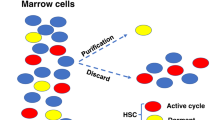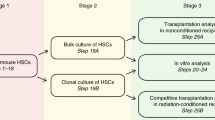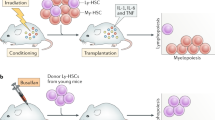Abstract
Mature erythrocytes and granulocytes have limited lifespans, do not replicate and must therefore be replenished constantly. They are derived from pluripotent stem cells (PSCs) which are capable of self-renewal1. The numbers and properties of PSCs can be inferred in part from studies of their progeny. Such studies have depended largely on highly artificial experimental systems, involving such procedures as X-ray irradiation, bone marrow transplantation and parabiosis2. We now describe a method for studying the behaviour of haematopoietic cell populations in normal mice, and show that erythropoiesis is maintained by the products of a very small number of clones which, as predicted by Kay3, arise and decline in succession. These results suggest that spleen colony-forming cells (CFC), usually regarded as stem cells, are themselves members of substantial clones which differentiate in sequence.
This is a preview of subscription content, access via your institution
Access options
Subscribe to this journal
Receive 51 print issues and online access
$199.00 per year
only $3.90 per issue
Buy this article
- Purchase on Springer Link
- Instant access to full article PDF
Prices may be subject to local taxes which are calculated during checkout
Similar content being viewed by others
References
Lajtha, L. G. Differentiation 14, 23–34 (1979).
Schofield, R. Blood Cells 4, 7–25 (1978).
Kay, H. E. M. Lancet ii, 418–419 (1965).
Lyon, M. F. Proc. R. Soc. B 187, 243–268 (1974).
Monk, M. & Harper, M. I. Nature 281, 311–313 (1979).
Fialkow, P. J. Ann. hum. Genet. 37, 39–48 (1973).
Gandini, E., Gartler, S. M., Agioni, G., Argiolas, N. & Dell Acqua, G. Proc. natn. Acad. Sci. U.S.A. 61, 945–948 (1968).
Nielsen, J. T. & Chapman, V. M. Genetics 87, 319–326 (1977).
Bücher, T., Bender, W., Fundele, R., Hofner, H. & Linke, I. FEBS Lett. 115, 319–324 (1980).
Wallis, V. J., Leuchars, E., Chwalinski, S. & Davies, A. J. S. Transplantation 19, 2–11 (1975).
Micklem, H. S. & Ross, E. in Human Lymphocyte Differentiation: Its Application to Cancer (eds Serrou, B. & Rosenfeld, C.) 15–22 (Elsevier, Amsterdam, 1978).
Russell, E. S. & Bernstein, S. E. in Biology of the Laboratory Mouse, 2nd edn (ed. Green, E. L.) 352 (McGraw-Hill, New York, 1966).
Testa, N. Clinics Haemat. 8, 311–333 (1979).
Chasin, L. A. & Urlaub, G. Somatic Cell Genet. 2, 453–467 (1976).
Johnston, P. & Cattanach, B. M. Genet. Res. 37, 151–160 (1981).
Author information
Authors and Affiliations
Rights and permissions
About this article
Cite this article
Burton, D., Ansell, J., Gray, R. et al. A stem cell for stem cells in murine haematopoiesis. Nature 298, 562–563 (1982). https://doi.org/10.1038/298562a0
Received:
Accepted:
Issue Date:
DOI: https://doi.org/10.1038/298562a0
This article is cited by
-
Chimeric drift in the erythrocyte population in BALB/c-C57BL/10 and BALB/c-B10.D2 mice
Bulletin of Experimental Biology and Medicine (1988)
Comments
By submitting a comment you agree to abide by our Terms and Community Guidelines. If you find something abusive or that does not comply with our terms or guidelines please flag it as inappropriate.



